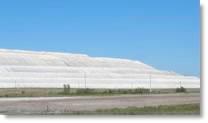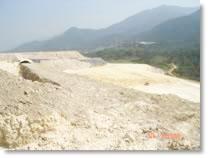TENORM: Fertilizer and Fertilizer Production Wastes
The most important use of phosphate rock is in the production of phosphate fertilizers. Due to its chemical properties, phosphate rock may contain significant quantities of naturally occurring radioactive materials (NORM):
- Uranium.
- Thorium.
- Radium.
- Their decay products
 decay productsThe atoms formed and the energy and particles emitted as radioactive material decays to reach a stable form..
decay productsThe atoms formed and the energy and particles emitted as radioactive material decays to reach a stable form..
Uranium concentrations in phosphate ores found in the U.S. range from 20 - 300 parts per million (ppm) (or 7 - 100 picocuries per gram (pCi/g)). while Thorium occurs at essentially background levels, between 1 - 5 ppm (or about 0.1 - 0.6 pCi/g).
Before phosphate ore is turned into fertilizer or other products, it is transformed into either phosphoric acid (through a wet process), or elemental phosphorus (through a thermal process). This processing concentrates NORM in the waste products, transforming them into Technologically Enhanced Naturally Occurring Radioactive Materials (TENORM).
Learn more about TENORM-producing industries and sources in the United States.
The yearly consumption of phosphate based fertilizers in the U.S. averaged close to 5.8 million metric tons (MT) between 1960 and 2007, and had increased to over 8.5 million MT by 2007. While phosphate fertilizers are not considered to be waste, they do contain some of the naturally occurring radium (Ra-226) found in phosphate ores.
The concentration of Ra-226 varies from approximately 5 - 30 pCi/g, depending upon the type of fertilizer blend and the origin of the phosphate rock.
Fertilizer application rates vary depending upon the type of crops and soils. A typical phosphate fertilizer application rate is about 40 kg per hectare (approximately 15 lbs. per acre). Fertilizers are available in over 100 different blends with varying concentrations of nitrogen, phosphorus and potassium. Further data on fertilizer consumption in the U.S. (but without data on radionuclide content) can be found on the Department of Agriculture's website.
Phosphate rock (phosphorite) mining is the fifth largest mining industry in the United States in terms of quantity of material mined. In 1989 the total production of phosphate rock in the U.S. was estimated at 38 million metric tons (MT). Most phosphate production leads to the making of fertilizers.
The phosphate industry is concentrated in the southeastern U.S. About 90 percent of domestic production capacity in Florida, North Carolina, and Tennessee. Florida alone accounts for approximately 80 percent of the current capacity, making it the world’s largest phosphate producing area. The western U.S. also has a phosphate industry, particularly in Idaho.
The wastes of most concern are the byproducts created during the wet and thermal processing steps of fertilizer production.
Phosphogypsum
Phosphogypsum is the primary waste byproduct of the wet-acid process for producing phosphoric acid. During this process sulfuric acid dissolves phosphate rock creating a solid/liquid mixture (slurry) of phosphoric acid and calcium sulfate (phosphogypsum). The desired phosphoric acid component is separated from the mixture by filtration, leaving phosphogypsum as the waste product.
 Side view of phosphogypsum stack
Side view of phosphogypsum stack
Phosphate production generates huge amounts of phosphogypsum wastes, nearly 48 million MTs in 1988 alone. Phosphogypsum has little market value and is hauled off as a slurry to waste piles called phosphogypsum stacks.
Phosphogypsum contains appreciable quantities of uranium and its decay products, such as radium-226, due to their high concentrations in phosphate ores. Uranium in phosphate ores found in the U.S. ranges in concentration from 7 - 100 picocuries per gram (pCi/g).
During the wet process, radionuclides present in the phosphate ore are selectively separated and concentrated. Around 80 percent of the radium-226 becomes concentrated in the phosphogypsum. Radium concentrations at phosphogypsum stacks range from 11 - 35 pCi/g.
Radon (Rn-222) can be found emanating from the surface of phosphogypsum stacks. Average radon fluxes range from 1.7 - 12 pCi/m2 per second and can be as high as 340 pCi/m2 per second, with a mean value of 6.8 pCi/m2 per second.
Radiation levels in phosphogypsum vary considerably from stack to stack and from different locations in a single stack due to a number of factors:
- Radium concentration in the phosphate rock.
- Emanation rate
 Emanation rateThe rate which radon will escape a matrix. Often expressed as a percentage. For soils, typical emanation rates are 20 – 30%; for scale or slag, ~1%..
Emanation rateThe rate which radon will escape a matrix. Often expressed as a percentage. For soils, typical emanation rates are 20 – 30%; for scale or slag, ~1%.. - Vegetation cover.
- Porosity
 PorosityThe capacity of soil or rock to hold water..
PorosityThe capacity of soil or rock to hold water.. - Moisture content.
- Presence of standing water.
- Temperature/barometric pressure.
Phosphogypsum has little market value and is hauled off as a slurry to huge waste piles called phosphogypsum stacks. The solid portion of the slurry consolidates while the water pools on the stack's surface. Eventually gypsum is dredged from the pools to build up the edges around the stack forming a reservoir for storing process water.
 Stacks are constructed with little or no soil preparation.
Stacks are constructed with little or no soil preparation.
Stacks are generally constructed on unused land or on mined out areas at production sites with little or no prior preparation of the land. They are not covered with soil or any other material.
There are over 70 identified stacks in the U.S. with the highest percentage found in Florida. The stacks are of considerable size ranging from 2 - 324 hectares (800 acres) in surface area and 3 - 60 meters in height.
Since there are large quantities of phosphogypsum waste, the industry encourages research into potential uses in order to minimize the disposal problem. The greatest use of phosphogypsum is in agricultural applications. Researchers proposing new uses must file an application with EPA.
Phosphogypsum has been used in agriculture as a source of calcium and sulfur for soils that are deficient in these elements. When the phosphogypsum is used as a fertilizer, it is simply spread on the top of the soil. When used for pH adjustment or sediment control, it is tilled into the soil.
The activity of phosphogypsum used for agricultural purposes may not exceed 10 pCi/g. An estimated 221,000 MT of phosphogypsum are taken from the phosphogypsum stacks and used in agriculture each year. There is no limitation on the amount of material that can be applied and farmers do not have to maintain certificates or application records.
In the past, phosphogypsum was incorporated into a Portland cement mixture for use in road construction. The use of phosphogypsum for such purposes is banned under the EPA final rule issued on June 3, 1992, which amends 40 CFR 61 Subpart R.
Phosphate Slag
Phosphate slag is the principle waste produced from the thermal process for the conversion of phosphate rock to elemental phosphorus. Production of elemental phosphorus, primarily in Idaho, has steadily gone down due to decreasing demand and increasing energy costs associated with its production.
Phosphate slag is a glassy substance created during furnace processing. Because of its physical properties and its high carbonate content, slag is less susceptible to radionuclide leaching than phosphogypsum. However, concentrations of uranium, thorium and radium in phosphate slag have been measured as high as 50 pCi/g in some instances.
The average radon measurements emanating from slag piles is just 0.5 picocuries per square meter (pCi/m2) per second. This is relatively low when compared to the radon measurements from native soil samples which range from 1.7 to 17 pCi/m2 per second.
Slag![]() SlagByproduct left after a desired metal is thermally separated from its raw ore. is generally stored in waste piles on site at production facilities. It has been reused for a variety of applications:
SlagByproduct left after a desired metal is thermally separated from its raw ore. is generally stored in waste piles on site at production facilities. It has been reused for a variety of applications:
- Highway construction aggregate (crushed base and crushed aggregate for asphalt).
- Portland cement and concrete (banned by the state of Idaho in 1977 for use in habitable construction).
- Railroad ballast and general construction.
Because of concerns over elevated radionuclide concentrations in phosphogypsum, the U.S. Environmental Protection Agency issued a final rule on June 3, 1992 amending 40 CFR 61 Subpart R. It states: "Phosphogypsum intended for agricultural use must have a certified average concentration of radium-226 no greater than 10 pCi/g." There is no limitation on the amount of material that can be applied and farmers do not have to maintain certificates or application records.
Due to concerns over radiation exposure, the State of Idaho has prohibited the use of phosphate slag in the construction of habitable structures since 1977.
